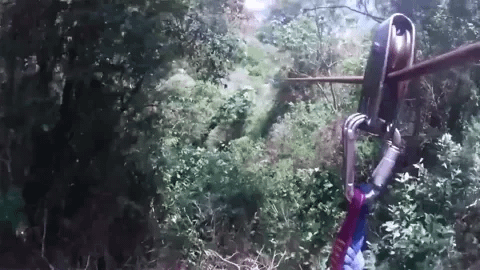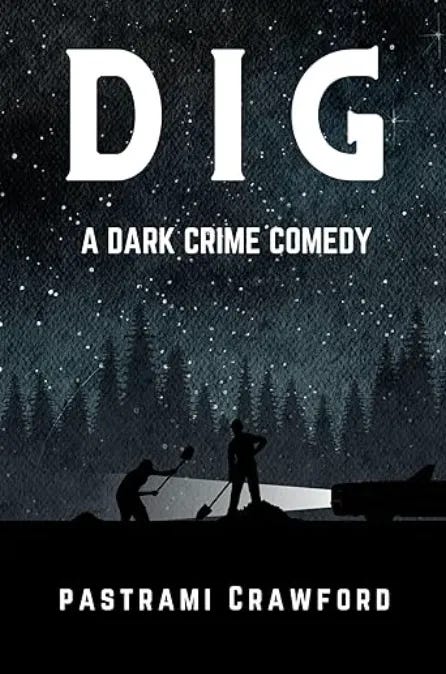Not long after the canyon zombie encounter, my wife and I pick up Captain Banjo from doggie day care. We drive back through the canyon. It’s quiet, and the light is perfect. The sun has set, everything glows purple, and this cues my mind to transition to night mode where I hit the mute button on my monkey brain.
As we hug a turn and crest the peak of a hill, I notice a sheet of fog. It drifts from the other lane, and we pass right through it. “Just one little sheet of fog,” I say. “That’s weird.”
“That wasn’t fog,” my wife says. She’s right. There’s no other moisture in the air.
“Ghost?” I say. I don’t believe in ghosts, but that zombie encounter was still fresh in our minds, and I like to keep her on her toes. She answers the question with nothing but a look—the same look mastered by wives the world over, the look that says, I have a life insurance policy on you and accidents happen every day.
“It might have been dirt kicked up on the shoulder,” she says.
“But…there haven’t been any oncoming cars…”
Immediately, we know what that might mean. The canyon is a veritable graveyard of cyclists, hikers, and motorists who never made it out alive. My wife makes a quick u-turn, and we double back to where we passed through the ghostly cloud of dust. Sure enough, two fresh tire marks—dark and rubbery—veer off the road at a 45-degree angle.
We pull over. The car must have gone over the edge into the ravine that hugs one side of the road. Thick with live oak trees, blankets of sage scrub, and thicket after thicket of prickly pear cacti, the ravine cuts deep, and it’s difficult to make sense of its chaos.
We’ve witnessed—like actually seen in real time—several cars fly off the road in the canyon, so we know how easily the canyon can swallow a vehicle. Added to this, it’s getting dark, so our vision is even more limited.
“Hello!” I yell. “Anyone out there?”
Moments pass…
“Hello!”
Another moment…
“Hell—”
“Heh-loh,” someone bellows in a thick Mexican accent, this followed by moaning.
“Are you okay?”
“Ayúdame…”
“Is that Spanish?” my wife asks.
“Yeah.” I dial 911. As it rings, I ask my wife if she can see him. She strikes the flashlight on her phone and sweeps it across the impending darkness. Next she dusts off her high school Spanish.
”¿Eh-stahs bee-en, uh-mee-go?” (Are you okay, friend?)
“¿Qué?” he says, confused. My wife got an A- in every Spanish class she ever took. An A for grammar and vocabulary, the minus for her pronunciation. On this day, my wife’s Spanish earns her the award for the Whitest Woman in Orange County.
911 answers and I’m giving them the details while my wife tries to clear up the confusion with the Mexican. "¿Don day ez too gotto?" she asks.
“Why are you asking him about a cat?”
“I thought gotto means car.”
“Carro means car. Gato means cat.”
“I was close.”
“Yeah, car, cat—it’s all the same to the Mexican whose guts are spread across his dashboard.”
“I’m trying!”
“I know you are, I’m sorry. Can you try to find out his name?”
“Yeah, uh… ¿Kokomo say llama?”
“¡Ay güey!" If you’re not a Spanish speaker, this essentially translates to, “For fuck sake, this white woman is gonna kill me.” He follows this up with, “Nacho! Me llamo Nacho!”
“He must be hallucinating. Why would he be eating nachos?”
“His name is Nacho.”
“Okay, and my name is burrito. We’re out here trying to save his life and he’s being funny?” If you were really quiet after my wife said this, you would have heard Cesar Chavez rolling around in his grave.
“Nacho is short for Ignacio, like the Spanish name for Ignatius.”
“Okay, that doesn’t make sense. It’s like Peggy being short for Margaret.”
At this point, we agree to switch roles. She handles the 911 operator, and I abuse the Spanish language. We still can’t see him or his car, so I try some echolocation. “¿Nacho?”
“¿Qué?”
I get a little better sense of where he might be, so I creep down the ravine a bit. I don’t know the word for echolocation, so I can’t explain what I’m doing. I just call his name again. “¿Nacho?”
“¿Qué? ¡¿Qué carajo?!” Nacho is getting pretty upset now, and this sucks for him, but it’s good for me because I finally see his car. And that’s when I realize that it really sucks for him.
He’s in a little Hyundai Accent, which would be more accurately called a Hyundai Toot-Toot, and it’s stuck in a live oak. He went over the ravine, and from the road, it looks like it’s just a thick swash of bushes, but really, it’s the canopy of a forest of live oaks, and his little Hyundai is hanging precariously in the branches, maybe 20 feet off the ravine’s steep slopes.
I owned a Hyundai Elantra once, and at that time, Hyundai’s slogan was Driving Is Believing. As I looked at Nacho’s Hyundai stuck in that tree, I thought I should write the company and tell them their marketing department nailed it.
“911’s asking about Nacho’s state.”
“Well, he’s stuck in a tree, so I guess he’s in a state of limbo.”
“Is he conscious?”
“Nacho?” No answer. “Nacho?! Stay with me Nacho!” As soon as I say it, I feel like a cliché character in a Michael Bay movie. But Nacho does respond. Barely. It sounds like he’s slipping in and out. Maybe he’s bleeding, maybe he’s in shock, maybe he’s realized that he’s defying laws of gravity in a big damn oak tree…
Then, because I’m goofy, it occurs to me that this whole situation feels like a great setup for a Dr. Seuss-style story.
The road took a curve, but Nacho did not, His Hyundai took a leap, and oh what a plot! It soared through the air with a whoosh and a breeze, Landing precariously in a live oak tree.
“The 911 operator says to keep him awake.”
It’s too dangerous to climb up into the tree and slap him or shake him, so I have to rely on my voice. I figure if I shout English at him, it will just be gibberish and he’ll nod off, so I start shouting the lyrics of Los Peces en el Río, a Mexican Christmas carol I learned in 6th grade as part of a multicultural unit:
“Pero mira cómo beben los peces en el río. Pero mira cómo beben por ver a Dios nacido. Beben y beben y vuelven a beber. Los peces en el río por ver a Dios nacer.”
He doesn’t sing along, but I hear him sort of mumbling, maybe humming, or—more likely—cursing me under his breath.
Soon, a fire truck arrives, followed by an ambulance, a cop car, and eventually a tow truck. My wife fills them in on what’s happened. Nothing about it seems to impress them or shock them. A Mexican balancing on a branch in Hyundai seems to strike them as a very pedestrian Tuesday evening. We pile back into our car to drive home with Captain Banjo. The expression on his face is roughly the same as all the first responders.
The next day we get a phone call from the police department. They tell us that Nacho is alive and will go on living, and that feels great. I should remind everyone here that it was my wife who put together the clues—the sheet of drifting dust, the skid marks, the conclusion that Nacho had spilled himself down into the canyon.
We drive over the crest of the hill nearly every day, and I always see that ghost-like sheet of dust in my mind’s eye. I don’t believe in ghosts or angels or any of that stuff, but I do believe that if you pay attention, the world has a way of using you in its creativity, whether you speak the language or not.
Thanks for reading. If you enjoyed this, consider reading some of my other adventures:
The Canyon Zombie and My Beautiful Wife: another story about mishaps in our canyon.
Bats, Buttloads, and BB Guns: a canyon man versus canyon nature story.
The Lifesaving Virtues of Super Glue: another story about a time we went out of our way to save a life, even though that life cost only five dollars.











Once again, your wife is the hero. Do you ever do anything?
"I guess he’s in a state of limbo” made me giggle -- I don't remember hearing this story in real life. It was really fun to read!